
NGC 5034 is a spiral galaxy in the constellation of Ursa Minor. NGC 5034 is its New General Catalogue designation. It is located about 401 million light-years from the Sun. It was discovered on April 7, 1793, by William Herschel.

NGC 3260 is an elliptical galaxy in the constellation Antlia. It is a member of the Antlia Cluster, which lies about 40.7 megaparsecs away. It was discovered on May 2, 1834 by the astronomer John Herschel.
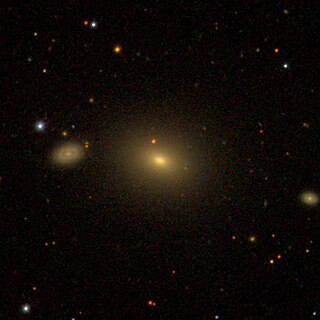
NGC 76 is a lenticular galaxy estimated to be about 320 million light-years away in the constellation of Andromeda. It was discovered by Guillaume Bigourdan from France in 1884 and its magnitude is 13.1.

NGC 4500 is a barred spiral galaxy in the constellation Ursa Major. The galaxy was discovered on April 17, 1789 by William Herschel. It is a blue compact galaxy.

NGC 7199 is a barred spiral galaxy registered in the New General Catalogue. It is located in the direction of the Indus constellation. It was discovered by the English astronomer John Herschel in 1835 using a 47.5 cm reflector.

NGC 999 is an intermediate spiral galaxy located in the constellation Andromeda about 195 million light-years from the Milky Way. It was discovered by French astronomer Edouard Stephan on 8 December 1871.

NGC 995 is a lenticular galaxy located in the constellation Andromeda about 178 million light years from the Milky Way. It was discovered by the French astronomer Édouard Stephan on 8 December 1871.

NGC 830 is a barred lenticular galaxy in the constellation Cetus. It is estimated to be about 170 million light-years from the Milky Way and has a diameter of approximately 70,000 light years.

NGC 900 is a lenticular galaxy located in the constellation Aries about 430 million light-years from the Milky Way. It was discovered by the German astronomer Albert Marth in 1864.
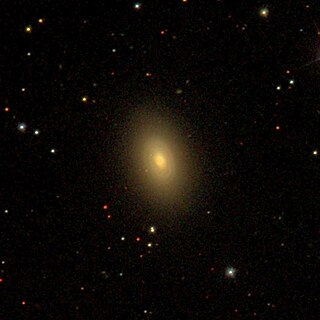
NGC 940 is a lenticular galaxy in the constellation Triangulum. It is estimated to be 222 million light-years from the Milky Way and has a diameter of approximately 80,000 ly. NGC 940 was discovered by Heinrich d'Arrest.

NGC 938 is an elliptical galaxy located in the constellation Aries, approximately 184 million light years from the Milky Way. It was discovered by the Prussian astronomer Heinrich d'Arrest in 1863.
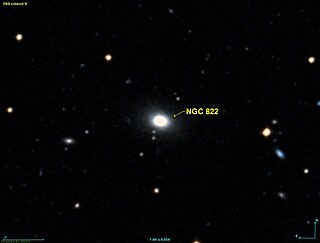
NGC 822 is an elliptical galaxy in the constellation Phoenix. It is estimated to be about 233 million light-years from the Milky Way and has a diameter of approximately 80,000 light-years. NGC 822 was discovered on September 5, 1834, by astronomer John Herschel.

NGC 823, also known as IC 1782, is an unbarred lenticular galaxy in the constellation Fornax. It is estimated to be 194 million light-years from the Milky Way and has a diameter of approximately 100,000 light years. NGC 823 was discovered on October 14, 1830, by astronomer John Herschel.
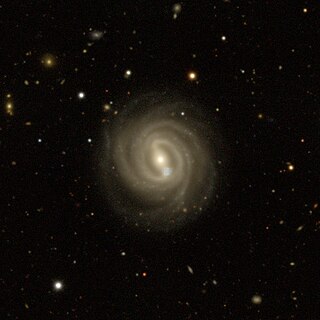
NGC 824 is a barred spiral galaxy located in the constellation Fornax about 260 million light-years from the Milky Way. It was discovered by British astronomer John Herschel in 1837.

NGC 2803, also known as PCG 26181, is an elliptical or lenticular galaxy in the zodiac constellation Cancer. It was discovered March 21, 1784, by William Herschel. It is interacting with NGC 2802.
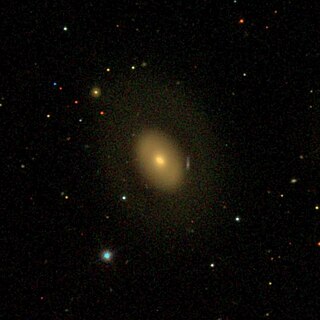
NGC 608 is a lenticular galaxy in the constellation Triangulum. It is estimated to be about 230 million light-years from the Milky Way. It has a diameter of approximately 130,000 light-years. NGC 608 was discovered on November 22, 1827, by astronomer John Herschel.

NGC 862 is an elliptical galaxy located in the constellation of Phoenix about 241 million light years from the Milky Way. It was discovered by the British astronomer John Herschel in 1834.

NGC 6509 is a spiral galaxy in the equatorial constellation of Ophiuchus. It was discovered on July 20, 1879 by the French astronomer Édouard Stephan. This galaxy is located at a distance of 95.3 million light-years (29.22 Mpc) from the Milky Way, and is receding with a heliocentric radial velocity of 1,814 km/s.

NGC 1001 is an unbarred spiral galaxy in the constellation Perseus. It was discovered on December 8, 1871 by the astronomer Édouard Stephan.
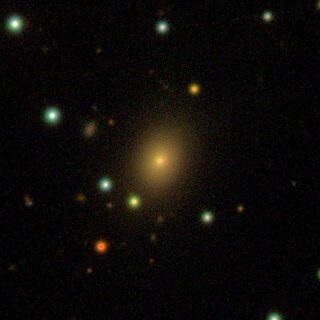
NGC 719 is a lenticular galaxy in the constellation Aries. It was first discovered, on 24 November 1861, by Heinrich d'Arrest.




















